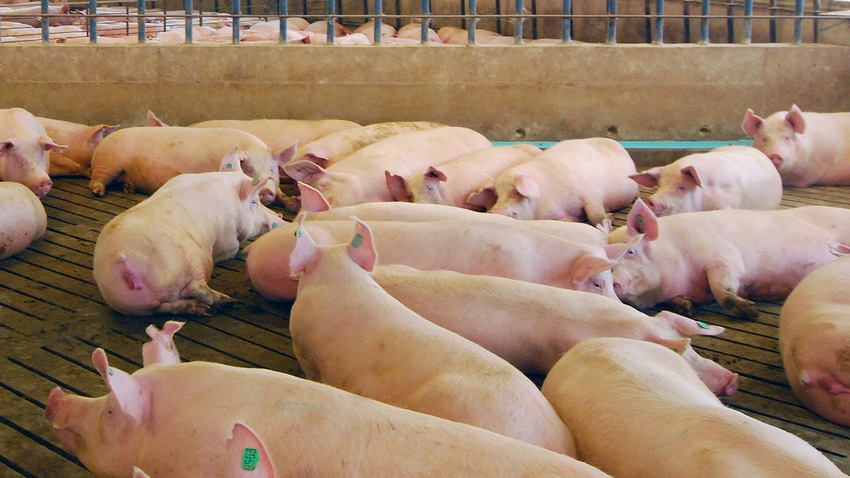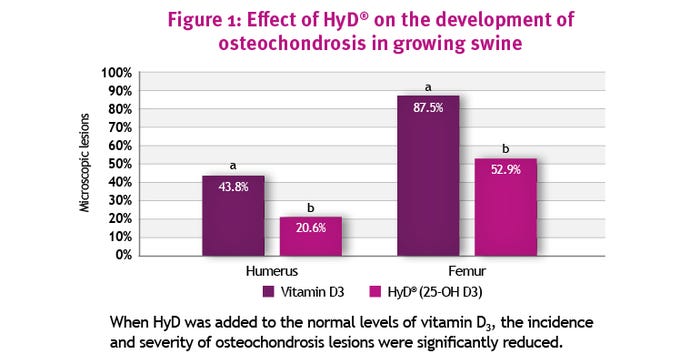Greater longevity in sow herd leads to increased productivity and profitability; a pure and proprietary form of 25-OH D3, the circulating form of D3, can be a tool in reaching this goal.
January 10, 2019

Sponsored Content
Successful swine herds are dependent on the next generation of females, with optimal skeletal development in gilts being a major goal. This includes the formation of adequate cartilage and bone matrix necessary for proper feet and leg conformation. And more fundamentally, sufficient vitamin D activity is essential for rapid cell differentiation during early bone formation because this is ultimately correlated with gilt mobility scores and gilt selection rates in swine herds.
Better bone development increases the number of high quality replacement gilts available at the time of replacement selection. The combination of a stronger skeletal frame and the maximization of pre-breeding vitamin D levels and mineral reserves is needed to reduce the culling rate associated with lameness in first-litter gilts and parity 1 sows.
Enabling gilts to maintain optimum levels of vitamin D is critical during this developmental period. Feeding 25-OH D3 can be a valuable tool in comprehensive gilt development programs because it promotes calcification and quickly elevates vitamin D status1. The addition of 25-OH D3 to feeds can enable gilts to maximize bone mineralization prior to the first breeding and can also reduce osteochondrosis lesions in the late finishing period, according to research (Figure 1).2

Sow Longevity and Lifetime Productivity
Maintaining productive capacity over successive parities is fundamental to sow herd profitability. The cost of gilt and sow development won’t be covered until their 3rd or 4th parity, and those that aren’t “paying for themselves” add costs to weaned pigs. Lameness is a major cause for sow mortality and culling.
Feeding 25-OH D3 to sows has produced greater bone density after two successive litters. The ability to maintain optimum vitamin D status can lower lameness-related replacement rates (Figure 2). Reductions in reproductive problems such as MMA (mastitis, metritis, agalactia) and Ca-related farrowing difficulties have also been linked to 25-OH D3. Whole herd productivity is dependent on maintaining optimum parity distribution. This can be accomplished with reduced cull rates in the early parities so that a sufficient number of parity 2 to parity 5 sows remain in the herd. Weaned pig cost is a direct consequence of the number weaned, and parity 2-5 sows are the most prolific and wean the greatest number of piglets.

In addition to sow productivity improvements, an optimum herd parity structure has ramifications on pig finishing costs. Pigs from P2+ sows experience lower mortality and convert feed more efficiently, another unseen benefit to reduced replacement rates.
Greater longevity in the sow herd leads to increased productivity and profitability, and this starts with gilt development. For more information about this research and how Hy•D, a pure and proprietary form of 25-OH D3, works better than supplementing with vitamin D alone, contact your DSM technical representative.
Click here to view the full article.
1Lauridsen, et al. 2010
2Sugiyama, T., et al. 2013. Effects of 25-hydroxy-cholecalciferol on the development of osteochondrosis in swine. Animal Science Journal 84, 341-349.
3Brana, D., et al. 2012. Nonruminant Nutrition: Vitamins and Minerals. American Society of Animal Science, Journal of Animal Science. Vol. 98, Supp 1. p. 114.
About the Author(s)
You May Also Like



